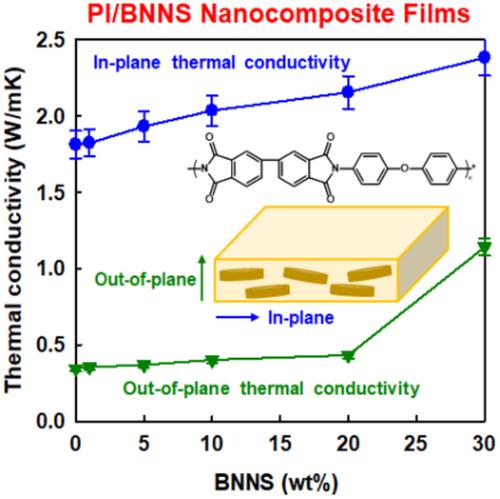当前位置:
X-MOL 学术
›
J. Appl. Polym. Sci.
›
论文详情
Our official English website, www.x-mol.net, welcomes your
feedback! (Note: you will need to create a separate account there.)
Enhanced mechanical and anisotropic thermal conductive properties of polyimide nanocomposite films reinforced with hexagonal boron nitride nanosheets
Journal of Applied Polymer Science ( IF 2.7 ) Pub Date : 2020-11-24 , DOI: 10.1002/app.50324 Gyu‐Hyun Hwang 1 , Young Seung Kwon 1 , Ji‐Su Lee 1 , Young Gyu Jeong 1
Journal of Applied Polymer Science ( IF 2.7 ) Pub Date : 2020-11-24 , DOI: 10.1002/app.50324 Gyu‐Hyun Hwang 1 , Young Seung Kwon 1 , Ji‐Su Lee 1 , Young Gyu Jeong 1
Affiliation

|
To attain thermally conductive but electrically insulating polymer films, in this study, polyimide (PI) nanocomposite films with 1–30 wt% functionalized hexagonal boron nitride nanosheets (BNNSs) were fabricated via solution casting and following imidization. The microstructures, mechanical and thermal conductive properties of PI/BNNS nanocomposite films were examined by taking account of the relative content, anisotropic orientation, and interfacial interaction of BNNS and PI matrix. The scanning electron microscopy, X‐ray photoelectron spectroscopy, Fourier transform infrared spectroscopy, and X‐ray diffractometry data revealed that BNNSs with hydroxy and amino functional groups have specific molecular interactions with PI matrix and they form stacked aggregates in the nanocomposite films with high BNNS loadings of 10–30 wt%. The tensile mechanical strength/modulus, thermal degradation temperatures, and thermal conductivity of the nanocomposite films were found to be significantly enhanced with increasing the BNNS loadings. For the nanocomposite films with 1–30 wt% BNNS loadings, the in‐plane thermal conductivity was measured to be 1.82–2.38 W/mK, which were much higher than the out‐of‐plane values of 0.35–1.14 W/mK. The significant anisotropic thermal conductivity of the nanocomposite films was found to be owing to the synergistic anisotropic orientation effects of both BNNS and PI matrix. It is noticeable that the in‐plane and out‐of‐plane thermal conductivity values of the nanocomposite film with 30 wt% BNNS were ~1.31 and ~3.35 times higher than those of neat PI film, respectively.
中文翻译:

六方氮化硼纳米片增强的聚酰亚胺纳米复合薄膜的增强的机械和各向异性导热性能
为了获得导热但电绝缘的聚合物薄膜,在本研究中,通过溶液浇铸和亚胺化制备了具有1–30 wt%的功能化六角形氮化硼纳米片(BNNS)的聚酰亚胺(PI)纳米复合薄膜。考虑到BNNS和PI基体的相对含量,各向异性取向以及界面相互作用,对PI / BNNS纳米复合膜的微观结构,力学性能和导热性能进行了研究。扫描电子显微镜,X射线光电子能谱,傅立叶变换红外光谱和X射线衍射数据表明,具有羟基和氨基官能团的BNNS与PI基质具有特定的分子相互作用,并且它们在具有高BNNS的纳米复合膜中形成堆积的聚集体负载量为10–30 wt%。发现纳米复合膜的拉伸机械强度/模量,热降解温度和热导率随着BNNS负载的增加而显着提高。对于具有1–30 wt%BNNS负载的纳米复合薄膜,测得的面内热导率为1.82–2.38 W / mK,远高于面外值0.35-1.14 W / mK。发现纳米复合材料膜的显着各向异性导热率是由于BNNS和PI基质两者的协同各向异性取向效应所致。值得注意的是,具有30 wt%BNNS的纳米复合膜的平面内和平面外热导率值分别比纯PI膜高约1.31倍和约3.35倍。纳米复合膜的热导率随BNNS负载的增加而显着提高。对于具有1–30 wt%BNNS负载的纳米复合薄膜,测得的面内热导率为1.82–2.38 W / mK,远高于面外值0.35-1.14 W / mK。发现纳米复合材料膜的显着各向异性导热率是由于BNNS和PI基质两者的协同各向异性取向效应所致。值得注意的是,具有30 wt%BNNS的纳米复合膜的平面内和平面外热导率值分别比纯PI膜高约1.31倍和约3.35倍。纳米复合膜的热导率随BNNS负载的增加而显着提高。对于具有1–30 wt%BNNS负载的纳米复合薄膜,测得的面内热导率为1.82–2.38 W / mK,远高于面外值0.35-1.14 W / mK。发现纳米复合材料膜的显着各向异性导热率是由于BNNS和PI基质两者的协同各向异性取向效应所致。值得注意的是,具有30 wt%BNNS的纳米复合膜的平面内和平面外热导率值分别比纯PI膜高约1.31倍和约3.35倍。测得的平面内热导率为1.82–2.38 W / mK,远高于平面外值0.35-1.14 W / mK。发现纳米复合材料膜的显着各向异性导热率是由于BNNS和PI基质两者的协同各向异性取向效应所致。值得注意的是,具有30 wt%BNNS的纳米复合膜的平面内和平面外热导率值分别比纯PI膜高约1.31倍和约3.35倍。测得的平面内热导率为1.82-2.38 W / mK,远高于平面外的0.35-1.14 W / mK值。发现纳米复合材料膜的显着各向异性导热率是由于BNNS和PI基质两者的协同各向异性取向效应所致。值得注意的是,具有30 wt%BNNS的纳米复合膜的平面内和平面外热导率值分别比纯PI膜高约1.31倍和约3.35倍。
更新日期:2020-11-24
中文翻译:

六方氮化硼纳米片增强的聚酰亚胺纳米复合薄膜的增强的机械和各向异性导热性能
为了获得导热但电绝缘的聚合物薄膜,在本研究中,通过溶液浇铸和亚胺化制备了具有1–30 wt%的功能化六角形氮化硼纳米片(BNNS)的聚酰亚胺(PI)纳米复合薄膜。考虑到BNNS和PI基体的相对含量,各向异性取向以及界面相互作用,对PI / BNNS纳米复合膜的微观结构,力学性能和导热性能进行了研究。扫描电子显微镜,X射线光电子能谱,傅立叶变换红外光谱和X射线衍射数据表明,具有羟基和氨基官能团的BNNS与PI基质具有特定的分子相互作用,并且它们在具有高BNNS的纳米复合膜中形成堆积的聚集体负载量为10–30 wt%。发现纳米复合膜的拉伸机械强度/模量,热降解温度和热导率随着BNNS负载的增加而显着提高。对于具有1–30 wt%BNNS负载的纳米复合薄膜,测得的面内热导率为1.82–2.38 W / mK,远高于面外值0.35-1.14 W / mK。发现纳米复合材料膜的显着各向异性导热率是由于BNNS和PI基质两者的协同各向异性取向效应所致。值得注意的是,具有30 wt%BNNS的纳米复合膜的平面内和平面外热导率值分别比纯PI膜高约1.31倍和约3.35倍。纳米复合膜的热导率随BNNS负载的增加而显着提高。对于具有1–30 wt%BNNS负载的纳米复合薄膜,测得的面内热导率为1.82–2.38 W / mK,远高于面外值0.35-1.14 W / mK。发现纳米复合材料膜的显着各向异性导热率是由于BNNS和PI基质两者的协同各向异性取向效应所致。值得注意的是,具有30 wt%BNNS的纳米复合膜的平面内和平面外热导率值分别比纯PI膜高约1.31倍和约3.35倍。纳米复合膜的热导率随BNNS负载的增加而显着提高。对于具有1–30 wt%BNNS负载的纳米复合薄膜,测得的面内热导率为1.82–2.38 W / mK,远高于面外值0.35-1.14 W / mK。发现纳米复合材料膜的显着各向异性导热率是由于BNNS和PI基质两者的协同各向异性取向效应所致。值得注意的是,具有30 wt%BNNS的纳米复合膜的平面内和平面外热导率值分别比纯PI膜高约1.31倍和约3.35倍。测得的平面内热导率为1.82–2.38 W / mK,远高于平面外值0.35-1.14 W / mK。发现纳米复合材料膜的显着各向异性导热率是由于BNNS和PI基质两者的协同各向异性取向效应所致。值得注意的是,具有30 wt%BNNS的纳米复合膜的平面内和平面外热导率值分别比纯PI膜高约1.31倍和约3.35倍。测得的平面内热导率为1.82-2.38 W / mK,远高于平面外的0.35-1.14 W / mK值。发现纳米复合材料膜的显着各向异性导热率是由于BNNS和PI基质两者的协同各向异性取向效应所致。值得注意的是,具有30 wt%BNNS的纳米复合膜的平面内和平面外热导率值分别比纯PI膜高约1.31倍和约3.35倍。











































 京公网安备 11010802027423号
京公网安备 11010802027423号